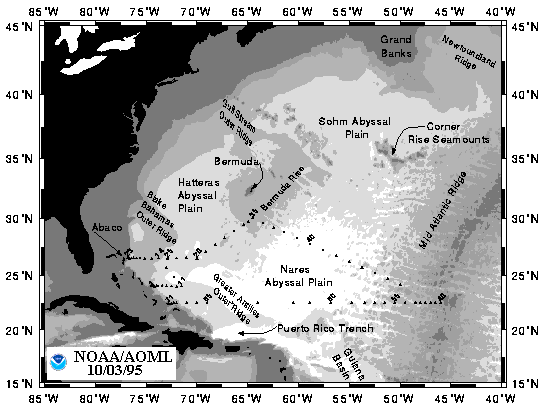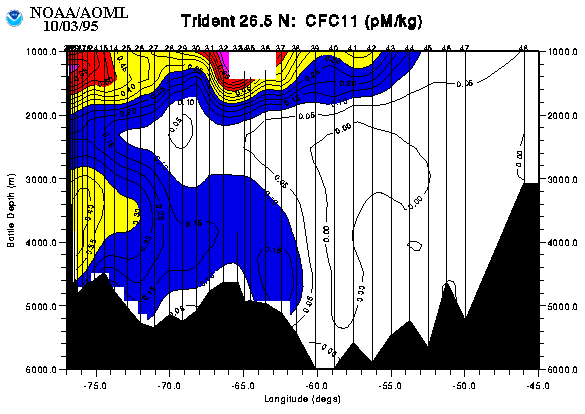DEEP WATER CIRCULATION IN THE WESTERN TROPICAL ATLANTIC: THE TRIDENT EXPEDITION
Principal Investigator:
Dr. Molly O'Neil Baringer
Collaborating
scientist(s):
Dr. Rana Fine, University of Miami, RSMAS
Dr. Robert Molinari
Mr. Doug Wilson
Objective:
Measuring the deep limb of the meridional overturning circulation
and assessing the representativeness of heat flux measurements
in the center of the subtropical gyre.
Rationale:
The meridional overturning circulation in the ocean
redistributes and stores heat and carbon input from the
atmosphere. During the last ice-age the present-day
overturning
circulation is thought to have been shut off
and replaced by a more vigorous component from the southern
ocean (around Anarctica).
 Long term monitoring of the heat flux in the center of
the Atlantic and measuring the components that make up the
'meridional overturning circulation' will help us understand
and predict long term trends in the earth's climate system.
Long term monitoring of the heat flux in the center of
the Atlantic and measuring the components that make up the
'meridional overturning circulation' will help us understand
and predict long term trends in the earth's climate system.
Method: Hydrographic and acoustic doppler
velocity data were collected during the August 1992 Trident Expedition (Figure 1).
 Accomplishment: The deepest, coldest component
of the meridional overturning circulation that originates near Antarctica
was found to flow northward between 22 and 26 N in the Atlantic (Figure 2).
Accomplishment: The deepest, coldest component
of the meridional overturning circulation that originates near Antarctica
was found to flow northward between 22 and 26 N in the Atlantic (Figure 2).
The heat flux between 22 and 26 N is fairly constant. This
suggests that long term monitoring of the heat flux in the
Atlantic could be based near 26N where a decade of current
meter observations have monitored the total water column
east of the Bahamas.
Key reference:
Baringer, M. O'Neil and Rana A. Fine, 1994.
Deep Circulation in the Western Subtropical North
Atlantic from Trident.
The Atlantic Climate Change Program Proceedings from
the principal
investigators meeting, May 9-11, 1992,
University Corporation for Atmospheric Research,
Boulder Colorado.
Hacker, P. and E. Firing and W. D. Wilson and
R. L. Molinari, 1996.
Direct Observations of the Current Structure East of
the Bahamas.
Geophysical Research Letters, 23, 1127-1130.
 Long term monitoring of the heat flux in the center of
the Atlantic and measuring the components that make up the
'meridional overturning circulation' will help us understand
and predict long term trends in the earth's climate system.
Long term monitoring of the heat flux in the center of
the Atlantic and measuring the components that make up the
'meridional overturning circulation' will help us understand
and predict long term trends in the earth's climate system.
 Accomplishment: The deepest, coldest component
of the meridional overturning circulation that originates near Antarctica
was found to flow northward between 22 and 26 N in the Atlantic (Figure 2).
Accomplishment: The deepest, coldest component
of the meridional overturning circulation that originates near Antarctica
was found to flow northward between 22 and 26 N in the Atlantic (Figure 2).